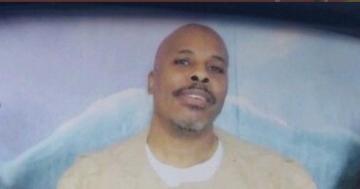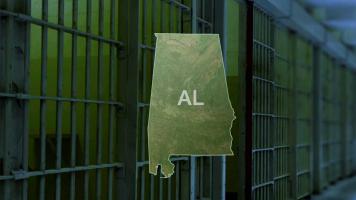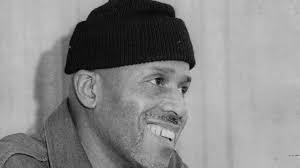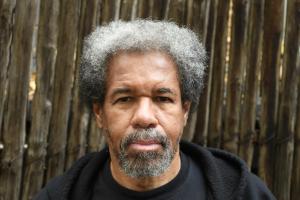In 1976, prisoners in the United States Penitentiary at Marion, Illinois wrote a collective document explaining the status of the prisoner within the prison—and the role of the prison in society at large.
Opened in 1963, the United States Penitentiary at Marion, Illinois was built to replace Alcatraz. Like Alcatraz, Marion was designed to incarcerate those individuals the federal government considered the most violent and dangerous. Unlike Alcatraz, an institution notorious for its archaic brutality, Marion deployed the latest in “modern” rehabilitation techniques. In 1968, prison officials launched a behavior modification program called the “Control and Rehabilitation Effort.” Known as CARE, the program used techniques of physical and psychological torture to terrorize and break the mind and spirit of prisoners, including “group therapy” sessions where prisoners were berated, degraded, and humiliated. In 1973, the first “control unit” cells were developed at Marion: for 23 to 24 hours a day, prisoners were placed under a maximum security regime, confined to a small, one-person cell with no contact with other prisoners or the outside world. Detention in the control units was indefinite and, as their use was designated an “administrative” action, prisoners were denied due process. In 1983, after a flash of violence the entire prison entered a lockdown that lasted twenty-three years.
Yet repression breeds resistance. Historically, the prisoners of Marion have organized and fought for better conditions, often with the support of those outside the prison walls. In 1972, a coalition of Black, Indian, Puerto Rican, and white prisoners initiated a series of mobilizations and lawsuits against the prison. In 1976, to coincide with the US Bicentennial, a group of inmates launched a prison strike to call attention to the brutality of CARE. Also in 1976, a small group of prisoners who called themselves “The Marion Prison Collective” produced an incredible document that both theorized the status of the prisoner within the prison, and explained the role of the prison in society at large. Titled “Notes of a Prison Collective,” it is a remarkable treatise on theory and practice, co-option, repression and counter-revolution, and on the difficult emergence of political and revolutionary consciousness. As part of our continuing commemoration of Black August, The Black Agenda Review reproduces it below.
NOTES OF A PRISON COLLECTIVE: MARION POLITICAL COLLECTIVE
Our collective has its origin in the concrete basis of the need for a collective force whose ideological base surpasses the narrow-minded nationalism and reactionary desire to imitate the Washington, D.C. form of gangsterism. As members of the convict class, we understand that we must be about the transformation of mice into conscious men of science, i.e., scientific social scientists. In order for anything to be changed, first it must be recognized that there is the necessity for change. This can only be accomplished through the development of theory out of practice and back to more theory and more practice. So it is out of the subjective recognition of the missing link in our objective surroundings that we have emerged.
The collective, which for purposes of identification we shall call: “The Marion Political Collective,” states in its prospectus, in part:
Objective: Primary short-term objective: elevation of political consciousness. Means: All available source material and manpower. Method: One-on-one political education; infiltration and politicization. Long Range Objective: Liberation of oppressed classes of this society. Method: Armed struggle and resocialization. Means: Propaganda and agitation. Need: Organizational structure as basis for future development. Method: Development and acceptance of Organization Programme. Foundation: Commitment to criticism/self-criticism; combat liberalism within self and organization; commitment to group study; commitment to practice.
Conscious discipline is self-initiated out of the recognition of necessity and is a reflection of political development. The primary method by which we maintain discipline is through raising the level of consciousness.
The preceding is not necessarily the order in which this statement of goals and aims appears. But it gives some indication of where we see ourselves heading and the guiding principles by which we intend to get there.
It has been some six or seven months now since we locked minds and efforts in an attempt to develop towards that more fully human, New Man. Those months included the period when we began to deliberately rap about what was needed. At the beginning, out of a population of four hundred men, we could only muster twelve. Three, however, turned tail and ran, and one very much needed brother is in segregation—the hole. So we have now dwindled to eight in population, moving among our peers. We are sure this problem is just a mirror of the overall internal and external problem that the total U.S. must accept and devise ways for dealing with. Still, the problem of indifference here in Marion among the “inmates” cannot be solely in [sic] dealt with, unless the tune which is being piped through the electronic-box station in the Washington, D.C.'s house of sinister plotters is understood. The tune’s lyrics go something like this: “Make Marion the most maximum of our cages, our behavior modification laboratory.” So in order to understand how, for instance, we discovered the need for “organizational structure as basis for future development,” it is necessary to have some idea of exactly what existed previously.
Mainly there were two loosely-knit organizations: one operated under the auspices of the chaplain's office, with its objective of bringing a more contemporary view to the religious context; the other was a black cultural group. In addition, there had been the ubiquitous prison presence of the Nation of Islam. Although the religious group and, under the regulations of the Bureau of Prisons, the cultural group were open to ethnic members other than blacks, both bodies were predominantly attended and operated by Afrikanamericans. (One reason for this, especially in relation to the religious group, might be found in the words of a white prisoner: “When you join an organization that’s mostly black, you have to function. And they're concerned with social problems and change.” Thus, most white prisoners are content to languish in socially inactive things, like the jaycees, etc.) So it is no exaggeration to say that these organizations were directly related to social problems that exist in the larger society-problems that do not cease to exist inside the prisons.
This is important to understand because of its direct relation to the consistent thread of development which gave substance to the recognition for a particular need, at another point in time. None of the postures that one would find in groups that function on the other side of prison boundaries were missing in these organizations. However, there is a real difference between what is happening in most federal joints as opposed to that which is happening in most of the state cages. Mainly, it is similar to the kind of illusionary democratic possibilities, or “humane” relations, that supposedly exist in the North, West, and East of the United States, as opposed to the South. The effect this has is that we recognize and relate to the truth of, say, George Jackson's or Martin Sostre's thesis: we know that the conditions are equally killing here, as they are in any other joint--but the methods operate at a more subtle level. This means that the demands for social consciousness beckon from a level much higher than that primary immediacy which brutally stabs the physical being and churns through the flesh, making it cry out right on the spot. Just as in America, it is frightfully real that most people believe they have a “right to work”—at the whim of their bosses’ generosity; in the same way, most federal prisoners see (because they are able to make a few pennies more than state prisoners) that they are not obliged to agitate for changes inside the prisons. Behavioral programs come down in the forms of rehabilitative things, with distant promises of parole, and thus affectionately remove the militant postures that used to pass as revolutionary desire.
So it can be readily seen that initially, these two groups had the same kind of “revolutionary desire”—which has finally been diagnosed as a genuine revolt to change social attitudes, without being righteously grounded in principled revolutionary understanding that would project toward the complete overturning of social relations, i.e., the kind of revolutionary desire that sees itself dissolving throughout the country into the myth of democratic liberalism. Thus, there was the “militant” push for black studies and history, for equality of participation by blacks in jobs, etc.; and when some of these demands were fulfilled through token response, it became easy for the militants to be complacent. Finally, the aim of the cultural group extended no further than getting women visitors to the weekly meetings. What was in the early stages a broad popular move, infused with political reality, became simply “pop culture” and moved to proudly de-politicize itself, thus assuring the “controllers” that the boat would not rock. Help was naturally in the offing: first, in reaction to a mass work-stoppage in 1972, all known political activists were locked up. Then, the next move was to bring in a number of “cadres” who had sold themselves out to the behavior modification program--as trainees, guinea pigs, and what have you. The results were a completely altered atmosphere, all in favor of the controllers and the aims that they projected.
Overtly, the move is “anti-prison-reformism.” Generally, there is consistent harassment, badly prepared food, and tampering with personal mail and books that are sent in from family or comrades. One known activist in segregation, Paul Duhart, was found hanging in his cell, which they claimed was suicide (see RT: A Journal of Radical Therapy, Summer, 1975). This happened less than four months ago. It is in the “control units” (segregation; prisons within prisons) that these more direct methods of control come into play. By means of behavior modification programs (Transactional Analysis in the extreme), authorities seek to forcibly restructure prisoners' personalities and thought processes, reducing rebellious spirits to pliant automatons (those who succumb) or vegetables (those who resist). Repeat: truly rebellious and conscious prisoners are often murdered. Long-term segregation, wherein social contact is kept to a minimum and sensory deprivation is dominant, serves to further terrorize prison populations into docility.
The opposite result, in the broad sense, manifested itself when the last of those activists was ordered released back into the general population by the court in December, 1973 (Adams v. Carlson). The nationalist tendency dominated the cultural group. It sought mainly to enhance the image of black history in the eyes of black prisoners, and to legitimize it in the eyes of the administration: the first related to and depended upon the second. So the primary political demand was to make it understood that black history legitimizes itself when it is correctly understood and critically examined, without an unbalanced glorification. To bring this political reality to the surface, it was necessary not only to become active in the group, but also to be involved in the organization's policy-making. This was accomplished. In the-meantime, Chicano prisoners made a move to establish a cultural group. Some members were involved with the Afrikanamerican culture group's political workshop. As they began to develop, during a so-called “probationary period,” the Latino population gave its wholehearted support. But at the end of the “probation, “they were declared to be too “political” by the administration. What remained to be done was the creation of an organizational structure that would transcend the popular limitations of administratively sanctioned groups. Thus, we arrived at the need for the collective, its goals, and its principles.
It was necessary to distinguish the difference between a “study group” and the collective as a political organization. The collective itself could not be a mere study group, although the membership of both would be primarily the same. We saw the study group as only a means to a greater end, with its purpose and function being determined by the need which created it. The central task of the collective, at this point in time, is to elevate the level of political consciousness among the prison population and among those who come directly or indirectly in line with the prison struggle situation. One of the means by which this mass politicization is realized is through political education via study groups. Considering the shortcomings of so-called “criminal mentality” and the gross lack of social understanding among prisoners, the need for political education is outstanding. It is a dire necessity to transform this “criminal mentality” into revolutionary consciousness; otherwise, the errors of past prison movements can only be repeated. Revolutionary consciousness turns historical errors into practical steppings stones. In prisons, there is a heavy need to recognize that the collective must first resolve the differences and contradictions in its understanding and application of the dialectical method to historical materialism--since it is from this basis that the principles of scientific socialist revolution arise and become clarified.
In the course of building a revolutionary collective in prison, contradictions arise during its development that are universal in nature; contradictions that could arise in any genuine revolutionary group. Initially, reliance is placed on past experience and on the manifestations of a particular level of consciousness relative to the individuals who are to make up the nucleus of the group.
The revolutionary consciousness that was presupposed, in some cases, did not exist. Accordingly, the practices of some individuals reflected the negation of revolutionary theory and practice, the negation of revolutionary principles, and total disregard for individual and organizational discipline. This contradiction emerged out of a superficial analysis of the individuals who were to become involved in the group. It is one thing to deal as an individual, and another thing altogether to deal collectively. This is a very important factor, for individualism manifests itself in many ways which are not readily comprehended until one moves to the higher sphere of collectivity. We recognized that in order to develop, to create theory and practice in its most concrete form, many contradictions would have to be resolved, and ideological clarity would have to be attained collectively. This way, we were prepared to combat all incorrect ideas, the success of which, in the final analysis, would be reflected in our practice.
The struggle to rid ourselves of all ideas and practices that impede growth and development caused some individuals to drop out. Rather than acknowledge their shortcomings, they blamed the organization. Those who remained, committed themselves to consistently struggle with their own shortcomings and the shortcomings of the organization as a whole. They realized that our strength and development depended on that of each and every member. With this in mind, steps were taken to utilize the methods of criticism/self-criticism on a collective and one-on-one basis. Also, get-acquainted sessions were instituted. Not only has this helped to resolve contradictions of a political nature, but also has aided us in understanding each other, which is an objective necessity. This is not to say that all contradictions have been resolved, for they will continue to arise as we continue to develop. But it has instilled in the minds of those still struggling that we are capable of resolving contradictions as a means to our organizational and individual development.
The collective now functions in the following way: as a collective we meet twice a week; the “study group” is also scheduled twice weekly. The sessions are devoted to studies for a minimum of one hour, with the remaining time used for political evaluations on the local level. Members are required to be active in the other loose-knit groups, which do not include the Nation of Islam. Criticism/self-criticism sessions are held monthly. We have elected a Responsible whose duties are to coordinate our studies and guide a correct political ideology and praxis. All members have an equal vote, including the Responsible. We evaluate problems on a collective basis by which democratic centralism rules. Thus, the majority voice, in any given situation, moves to convince the minority that decisions should be based on revolutionary principles.
Politically conscious prisoners are concerned with concrete issues. Of particular consideration is the function of prisons in capitalist society. During the course of study, each theoretical concept must be analyzed in terms of its relation to the day-to-day activities of prisoners in an economic, social, and political context. Such critical examination enables a collective to develop insights into the particular contradictions between prisons and society in general, and more importantly, the particular contradictions within particular prisons. The basic understanding is that the main function of prisons is to serve as the apex of social coercion within the capitalist economy. The warehousing of prisoners, therefore, serves a two-fold purpose: 1) it removes from the community those who refuse to submit to economic deprivation; and 2) it extracts exploitative profits through compulsory labor at slave wages.
Once captured, the concept begins to expand. One comes to recognize the means and methods utilized within prisons as amplified versions of the coercive tactics used on society-at-large, for (again) prisons are microcosms of the national situation.
In “population,” i.e., where the bulk of prisoners reside that parallels the external community, manipulation is the rule. Make-work programs divert attention from the conditions. Trivia dominates prisoners’ minds: movies, outside shows, purpoless education (both academic or outmoded vocational training), and dysfunctional “rehabilitation programs,” e.g. drug therapy, jaycees, historical societies, and so forth. For the opportunistic, subtle Transactional Analysis groups function as channels for capitalist values. Rehabilitation rhetoric is projected, while in actuality all prospects for genuine rehabilitation are thwarted, or deliberately subverted by careful selection of those most apt to fail on such experimental projects as work release, furloughs, etc.
As in the large society, racism is perpetuated by administrators through discriminatory practices in quarters assignments, job placements in preferred positions, allocation of funds to prisoners groups, and paroles. It is also rewarded when employed by reactionary prisoners, predominantly opportunistic whites. Political whites are rare. Those few who might seek communication with Third World prisoners, the most politically active, are subject to peer pressure which ultimately hinders development. The conscious and active, however, irrespective of color, are harassed or negated ceaselessly, which necessarily evolves into a pariah situation once issues are joined. Clearly, racism is a tool in the interest of the enemy and defeats any attempt to combat common problems among prisoners, especially when repression comes down.
In dealing with repression, where the principal contradiction between the administration and prisoners has heightened, our historical analysis has proven that a given course of action is advantageous to our position. The most necessary move is to have some base for a united action front. It is our most formidable weapon. We have to bring, as much as possible, discipline into the broad ranks of the prisoners so that we can operate as a unit, with as many as possible being aware of what is going on at all times. In whatever situation, no matter what degree the crisis, letter-writing campaigns are utilized as a means to expose the fascist-like atrocities enacted by the authorities. In terms of reaching broad masses of people, and at the same time raising the level of prisoner consciousness, the courts have proven to be an effective means. But it is highly important that we always understand that they are a means and not the solution to the problem of prison or social problems in general. We have referred to the Adams v. Carlson class-action suit; presently another suit, Bono v. Saxbe, which challenges the control units in this joint, is being heard. A favorable decision, releasing many of those who are politically active and who have been stuffed in the control units without having entered the general population, could very well push the contradiction to another level.
Aside from this article, the collective has not published as a collective. Our outlet has remained the cultural newsletter, which generally reflects our development. This outlet has provided us numerous contacts with the developing movement in the “open society” and with prisoners in other state and federal joints. This, in turn, has enabled us to get most of the resource materials we need and to engage in dialogues with organizations, staff people working with periodicals, and others concerned with the movement for social justice.
At the moment, for the purposes of developing a collective understanding of revolutionary socialist theory and practice, we are dealing with the philosophical essays of Mao, studying Marx, and moving to deal with Lenin. Since most of us have previously studied, on an individual level, and devoted more than a little time to a scientific understanding of racism and its ramifications in this advanced capitalist society, we find it relatively beneficial to relate our past experience to our developing understanding.
The stage at which we are now is in itself a development; a qualitative leap from the old to the new. It represents the struggle to develop ideological clarity, collectivity, consistency, and a greater understanding of what is necessary in order to build the revolution. Just as ideas do not fall from the sky, neither do revolutionary consciousness, revolutionary practice, or the revolutionary people who must understand the needs of the masses and be capable of fulfilling them with the masses. We are consistently seeking to realize this reality. The development achieved has posed and will continue to pose other contradictions, and will necessitate the struggle to resolve the old which will bring in the new. But we will resolve them. For our direction is to develop, to struggle with ideological clarity, and to manifest consistency in all we say and do. We see the value of this as being applicable to the basic development of any prisoners’ political collective.
Originally published in Crime and Social Justice, No. 5 (Spring-Summer 1976).
*Previous posts from our “Black August” 2021 focus have included “Two Letters on Black August,” written in 1979 by men incarcerated in San Quentin, and the 1971 Attica Liberation Manifesto.



















